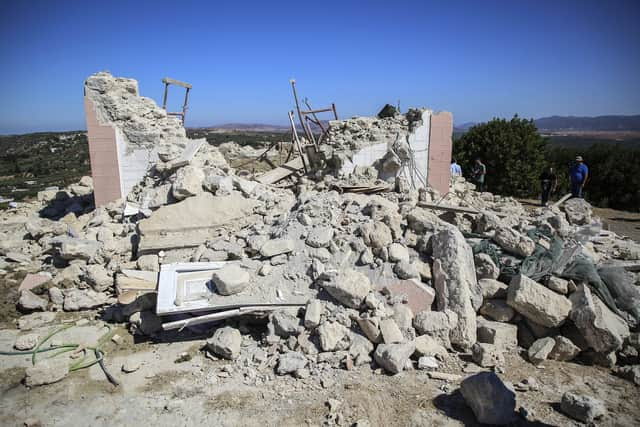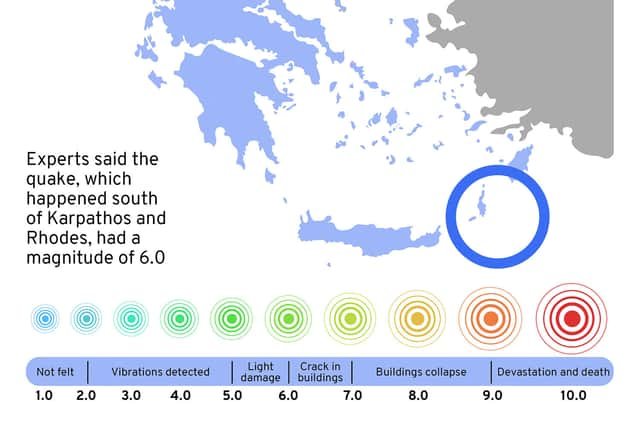Greece earthquake: further tremors felt after 6.0 magnitude quake hits Greek islands of Rhodes and Karpathos
and live on Freeview channel 276
Further tremors have been felt in the Mediterranean just hours after a powerful earthquake struck near the Greek islands of Karpathos and Rhodes.
Several minor earthquakes were recorded off the island of Crete in the early hours of this morning (20 October).
Advertisement
Hide AdAdvertisement
Hide AdThe largest measured 4.3 on the Richter scale when it hit hat 5.45am, according to the European Mediterranean Seismological Centre (EMSC), while a further four tremors with magnitudes between 3 and 3.4 were recorded between 4.30am and 9am local time.
The EMSC said the biggest quake struck at a depth of 10km in the east of the island, close to the town of Irákleion.
No casualties or major damage have been reported.
Crete has been hit by two major quakes measuring above 6.0 in magnitude since the end of September, one of which killed one person and caused extensive damage on the island.
These new tremors also come just 24 hours after a 6.0 magnitude earthquake hit Crete’s neighbouring islands of Karpathos and Rhodes on Tuesday (19 October).


Advertisement
Hide AdAdvertisement
Hide AdIt was felt across the Eastern Mediterranean, with tremors reaching Israel and Egypt, which are both more than 500km away.
But despite its strength, there have been no reports of casualties or damage to infrastructure.
We want to hear from you: let us know what you think about this story and be part of the debate in our comments section below
What happened yesterday?
Yesterday’s earthquake struck in the early hours of Tuesday morning.
Advertisement
Hide AdAdvertisement
Hide AdWitnesses reported to the EMSC website that the tremors lasted for around 30-seconds and violently shook their belongings.
One witness in Lindos, Rhodes, wrote: “Wow! Really felt that one! Curtains moving, chair moving in a weird side to side and round motion - felt quite seasick! Lasted for 30 seconds.”


The earthquake has been recorded at 6.0 on the Richter scale by the US Geological Survey (USGS), which said it struck at a depth of 23.5 miles (37.8km).
This estimate differs from the EMSC’s, which put the magnitude at 6.4.
Advertisement
Hide AdAdvertisement
Hide AdIt’s common for different seismological institutes to report varying levels of earthquake magnitudes in the initial hours following an earthquake.
At that strength, earthquakes can cause light damage and cracks in buildings. However, it is usually not strong enough to wreak devastation and death.
As well as shaking other Greek islands, including Crete and Santorini, tremors were felt as far away as Beirut, Cairo and areas of Israel and Palestine.
A seismologist told Reuters that no aftershocks were expected.
What causes an earthquake?
Advertisement
Hide AdAdvertisement
Hide AdThe USGS explains that earthquakes are caused “by a sudden slip on a fault”.
The earth’s tectonic plates are always slowly moving, but they can get stuck, and when this happens pressure begins to build up, and then “there is an earthquake that releases energy in waves that travel through the earth’s crust and cause the shaking that we feel”.
The waves are felt the most strongly at the epicentre, and this is where the most severe damage will occur.
The USGS says that the biggest earthquake in history happened in Bio-Bio, Chile, in 1960.
Advertisement
Hide AdAdvertisement
Hide AdKnown as the Valdivia Earthquake, it happened on 22 May 1960 and various studies have placed the magnitude of the earthquake between 9.4 and 9.6.
It lasted for approximately 10 minutes, and the resulting tsunamis affected southern Chile, Hawaii, Japan, the Philippines, New Zealand, Australia and the Aleutian Islands.
A message from the editor:
Thank you for reading. NationalWorld is a new national news brand, produced by a team of journalists, editors, video producers and designers who live and work across the UK. Find out more about who’s who in the team, and our editorial values. We want to start a community among our readers, so please follow us on Facebook, Twitter and Instagram, and keep the conversation going. You can also sign up to our email newsletters and get a curated selection of our best reads to your inbox every day.
Comment Guidelines
National World encourages reader discussion on our stories. User feedback, insights and back-and-forth exchanges add a rich layer of context to reporting. Please review our Community Guidelines before commenting.
